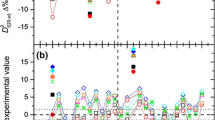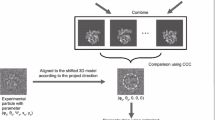Abstract
The shape of simple and complex biological macromolecules can be approximated by bead modeling procedures. Such approaches are required, for example, for the analysis of the scattering and hydrodynamic behavior of the models under analysis and the prediction of their molecular properties. Using the atomic coordinates of proteins for modeling inevitably leads to models composed of a multitude of beads. In particular, for hydrodynamic modeling, a drastic reduction of the bead number may become unavoidable to enable computation. A systematic investigation of different approaches and computation modes shows that the ‘running mean’, ‘cubic grid,’ and ‘hexagonal grid’ approaches are successful, provided that the extent of reduction does not exceed a factor of 100 and the grid approaches use beads of unequal size and the beads are located at the centers of gravity. Further precautions to be taken include usage of appropriate interaction tensors for overlapping beads of unequal size and appropriate volume corrections when calculating intrinsic viscosities. The applied procedures were tested with the small protein lysozyme in a case study and were then applied to the huge capsid of the phage fr and its trimeric building block. The appearance of the models and the agreement of molecular properties and distance distribution functions of unreduced and reduced models can be used as evaluation criteria.
Similar content being viewed by others
References
Glatter, O., Kratky, O. (eds.): Small Angle X-ray Scattering. Academic, London (1982)
Durchschlag, H.: Small-angle X-ray scattering of proteins in relation to food systems, with special emphasis on enzymes and storage proteins. In: Baianu, I.C., Pessen, H., Kumosinski, T.F. (eds.) Physical Chemistry of Food Processes, Vol. 2 Advanced Techniques, Structures, and Applications, pp. 18-117. Van Nostrand Reinhold, New York (1993)
Harding, S.E., Rowe, A.J., Horton, J.C. (eds.): Analytical Ultracentrifugation in Biochemistry and Polymer Science. Royal Society of Chemistry, Cambridge (1992)
Scott, D.J., Harding, S.E., Rowe, A.J. (eds.): Analytical Ultracentrifugation: Techniques and Methods. Royal Society of Chemistry, Cambridge (2005)
Svergun, D.I., Koch, M.H.J.: Small-angle scattering studies of biological macromolecules in solution. Rep. Prog. Phys. 66, 1735–1782 (2003)
Zipper, P., Durchschlag, H., Krebs, A.: Modelling of biopolymers. In: Scott, D.J., Harding, S.E., Rowe, A.J. (eds.) Analytical Ultracentrifugation: Techniques and Methods, pp. 320-371. Royal Society of Chemistry, Cambridge (2005)
García de la Torre, J., Navarro, S., López Martínez, M.C., Díaz, F.G., López Cascales, J.J.: HYDRO: a computer program for the prediction of hydrodynamic properties of macromolecules. Biophys. J. 67, 530-531 (1994)
García de la Torre, J., Huertas, M.L., Carrasco, B.: Calculation of hydrodynamic properties of globular proteins from their atomic-level structure. Biophys. J. 78, 719-730 (2000)
Zipper, P., Durchschlag, H.: Calculation of hydrodynamic parameters of proteins from crystallographic data using multibody approaches. Prog. Colloid & Polym. Sci. 107, 58-71 (1997)
Zipper, P., Durchschlag, H.: Recent advances in the calculation of hydrodynamic parameters from crystallographic data by multibody approaches. Biochem. Soc. Trans. 26, 726-731 (1998)
Zipper, P., Durchschlag, H.: Prediction of hydrodynamic and small-angle scattering parameters from crystal and electron microscopic structures. J. Appl. Crystallogr. 33, 788-792 (2000)
Zipper, P., Krebs, A., Durchschlag, H.: Prediction of hydrodynamic parameters of Lumbricus terrestris hemoglobin from small-angle X-ray and electron microscopic structures. Prog. Colloid & Polym. Sci. 119, 141-148 (2002)
Zipper, P., Durchschlag, H.: Modeling of protein solution structures. J. Appl. Crystallogr. 36, 509-514 (2003)
Krebs, A., Durchschlag, H., Zipper, P.: Small angle X-ray scattering studies and modeling of Eudistylia vancouverii chlorocruorin and Macrobdella decora hemoglobin. Biophys. J. 87, 1173-1185 (2004)
Durchschlag, H., Zipper, P.: Calculation of volume, surface, and hydration properties of biopolymers. In: Scott, D.J., Harding, S.E., Rowe, A.J. (eds.) Analytical Ultracentrifugation: Techniques and Methods, pp. 389-431. Royal Society of Chemistry, Cambridge (2005)
Zipper, P., Durchschlag, H.: Modelling of bacteriophage capsids and free nucleic acids. J. Appl. Crystallogr. 40, s153-s158 (2007)
Durchschlag, H., Zipper, P., Krebs, A.: A comparison of protein models obtained by small-angle X-ray scattering and crystallography. J. Appl. Crystallogr. 40, 1123-1134 (2007)
Durchschlag, H., Zipper, P.: Volume, surface and hydration properties of proteins. Prog. Colloid & Polym. Sci. in press (2008)
Berman, H.M., Westbrook, J., Feng, Z., Gilliland, G., Bhat, T.N., Weissig, H., Shindyalov, I.N., Bourne, P.E.: The protein data bank. Nucleic Acids Res. 28, 235-242 (2000)
Durchschlag, H., Zipper, P.: Modeling the hydration of proteins at different pH values. Prog. Colloid & Polym. Sci. 127, 98-112 (2004)
Traube, J.: Ueber den Raum der Atome. Samml. chem. chem.-tech. Vortr. 4, 255-332 (1899)
Sayle, R.A., Milner-White, E.J.: RASMOL: biomolecular graphics for all. Trends Biochem. Sci. 20, 374-376 (1995)
Glatter, O.: Computation of distance distribution functions and scattering functions of models for small angle scattering experiments. Acta Phys. Austriaca 52, 243-256 (1980)
García de la Torre, J., del Rio Echenique, G., Ortega, A.: Improved calculation of rotational diffusion and intrinsic viscosity of bead models for macromolecules and nanoparticles. J. Phys. Chem. B 111, 955-961 (2007)
Zipper, P., Durchschlag, H.: Prediction of hydrodynamic parameters from 3D structures. Prog. Colloid & Polym. Sci. 113, 106-113 (1999)
Carrasco, B., García de la Torre, J., Zipper, P.: Calculation of hydrodynamic properties of macromolecular bead models with overlapping spheres. Eur. Biophys. J. 28, 510-515 (1999)
García de la Torre, J., Carrasco, B.: Intrinsic viscosity and rotational diffusion of bead models for rigid macromolecules and bioparticles. Eur. Biophys. J. 27, 549-557 (1998)
García de la Torre, J., Bloomfield, V.A.: Hydrodynamic properties of complex, rigid, biological macromolecules: theory and applications. Q. Rev. Biophys. 14, 81-139 (1981)
García Bernal, J.M., García de la Torre, J.: Transport properties of oligomeric subunit structures. Biopolymers 20, 129-139 (1981)
Author information
Authors and Affiliations
Corresponding author
Rights and permissions
About this article
Cite this article
Zipper, P., Durchschlag, H. Modeling Complex Biological Macromolecules: Reduction of Multibead Models. J Biol Phys 33, 523–539 (2007). https://doi.org/10.1007/s10867-008-9063-6
Received:
Accepted:
Published:
Issue Date:
DOI: https://doi.org/10.1007/s10867-008-9063-6




